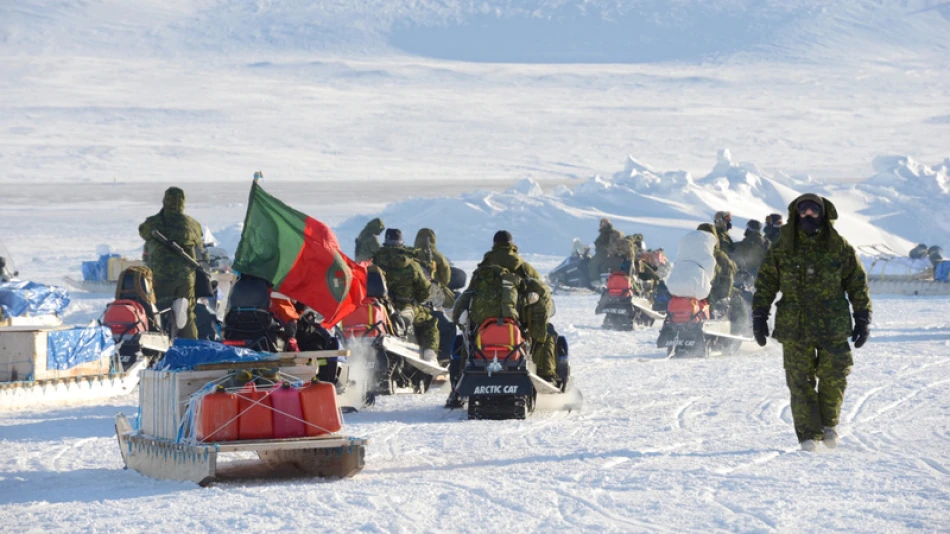
Guardians of the Arctic: Canada's Watchful Eyes and Ears in the Far North
Canada's Arctic Defense Revolution: Why Military Might Alone Won't Secure the North
Canada is fundamentally rethinking Arctic security as geopolitical tensions escalate, moving beyond traditional military approaches to embrace community-based defense strategies. With 40% of Canadian territory lying in the Arctic, the country is investing billions in defense spending while pioneering a model that combines military presence with strengthened local communities and indigenous partnerships.
The Arctic Rangers: Eyes and Ears of the North
In June, as the midnight sun illuminated Canada's far northwest, a four-person team of Arctic Rangers conducted routine operations outside Yukon's capital. These volunteer reserve soldiers have long served as Canada's "eyes and ears" in the far north, but their mission has become dramatically more complex and dangerous.
The Rangers represent a unique approach to Arctic security that emphasizes local knowledge and community presence over heavy militarization. As Sergeant John Welsh explains: "We won't secure the Arctic by arming it, but if our communities are strong and our people are trained and present on the ground, they'll notice anything unusual, including an unregistered boat in the water or mining operations on an Arctic island."
A Wake-Up Call from Above
The strategic importance of this approach became crystal clear in early 2023 when a Chinese high-altitude balloon traversed Alaska, western Canada, and the U.S. mainland before being shot down off South Carolina. Just weeks later, the North American Aerospace Defense Command (NORAD) downed another object over indigenous territory in Yukon.
The incident exposed critical gaps in Canada's Arctic defense coordination. Military officials and police rushed to central Yukon to locate the debris, relying on Arctic Rangers for terrain expertise, but communication breakdowns revealed the fragility of existing security networks, particularly with indigenous governments.
Communication Breakdown Reveals Systemic Flaws
Former Yukon Premier Ranj Pillai, who had been in office for just one month when the balloon incident occurred, witnessed the chaos firsthand. "We watched the Canadian Armed Forces mobilize, but we saw gaps in their ability to communicate with Yukon residents," he recalled. The event highlighted how Canada's Arctic security had been examined only during crisis periods, most recently during the Cold War.
Massive Defense Investment Meets Community Strategy
Canada's response has been swift and substantial. In June 2024, Prime Minister Mark Carney announced a $6.6 billion increase in defense spending to meet NATO's 2% GDP target by March 2026, stating that "threats that seemed distant and remote are now immediate and acute." At the subsequent NATO summit in The Hague, Canada committed to raising defense spending to 5% of GDP by 2032.
Crucially, the new NATO framework allows members to allocate 1.5% of this spending to civilian infrastructure like roads and communications that serve both military and local community needs. This dual-use approach forms the philosophical foundation of Yukon's Arctic security strategy.
Beyond Traditional Military Infrastructure
The Canadian Department of Defense announced a massive northern expansion in March 2024, including new centers, aircraft landing strips, and equipment to support a more permanent Canadian Armed Forces presence. Canada is also appointing a new Arctic ambassador and opening two Arctic consulates in Alaska and Greenland.
The Yukon Model: Community-Centered Security
Yukon's approach offers a compelling alternative to purely military solutions. In March 2025, the territorial government launched the Canadian Arctic Security Institute, working closely with Arctic Rangers, other military branches, federal and indigenous governments, and international partners to redefine what "securing" the north means.
This model recognizes that effective Arctic security requires more than military hardware. Yukon's vast northern territories above the Arctic Circle remain largely unpopulated except for one community accessible only by air. Protected by Alaska to the west and isolated by hundreds of miles of Canadian wilderness from the North Atlantic, Yukon has historically received less military attention than its neighbors.
Global Context: Rethinking Defense Spending
Canada's approach reflects a broader global reconsideration of defense spending as serving both state and community objectives. Unlike the militarized approaches seen in other Arctic nations like Russia, or the technology-heavy strategies favored by allies like Norway, Canada is betting on human intelligence networks and community resilience.
Strategic Implications for Arctic Geopolitics
This community-centered security model could reshape Arctic geopolitics significantly. As climate change opens new shipping routes and resource extraction opportunities, the traditional model of projecting power through military bases and equipment may prove insufficient for monitoring and controlling such vast territories.
Canada's emphasis on indigenous partnerships and local knowledge represents a sustainable competitive advantage that other Arctic nations will struggle to replicate. The Arctic Rangers' deep territorial familiarity and community connections create an intelligence network that sophisticated surveillance technology cannot easily replace.
The success of this approach will likely influence how other nations with extensive remote territories approach security challenges, potentially offering a template for countries from Australia to Brazil facing similar geographic and resource protection challenges in their frontier regions.
Most Viewed News

 Sara Khaled
Sara Khaled






